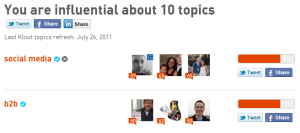My post last week about the shortcomings of Klout got several thousand views and generated quite a bit of discussion. it also got me several e-mails from companies that claim to have built a better mousetrap than Klout. I haven’t reviewed these tools in detail just yet, but it appears that influence is a red-hot topic in PR and marketing circles right now.
Influence measurement is a natural evolution of conversation monitoring, a discipline that’s personified by Salesforce.com’s Radian6 tool and dozens of competitors. Monitoring is a solid practice that can keep you in touch with the topics and brands people are discussing online. Most tools now also provide some degree of sentiment analysis, which attempts to derive attitudes from comments. Sentiment analysis is devilishly difficult to get right, however. If a teenager calls something “sick,” it’s a compliment. Coming from a 50-year-old, it’s an insult. Most experts I’ve spoken to on this topic say that sentiment analysis tools are at best 70% accurate.

Topaz Partners has developed the "Circle of Influence" to depict the different factors that go into decision-making (Click to enlarge). TopazPartners.com
This isn’t stopping vendors from tackling the even more complex issue of Influence analysis. This goes beyond sentiment analysis to attempt to determine a person’s ability to drive action. The problem is that there are lots of variables and intangibles to influence that resist being boiled down to a single number. For example:
- What is action? A “like” or retweet is a form of action, but not necessarily one that leads to a decision.
- Online actions have different gravity depending upon the stakes and the effort involved. Writing a comment takes more effort than clicking a “like” button. Posting a blog entry referencing someone else’s words is more involved than writing a comment.
- Which actions really matter? I have yet to see a tool that can correlate influence with purchases or donations with any degree of certainty. We assume that conversation about a topic influences decisions, but are they the decisions we want? A lot of people have been talking about Hewlett-Packard lately, but I doubt it’s driving profitable sales of HP products.
- Influence is contextual. If I’m considering buying a Yamaha stereo and find a blog entry from someone who exhibits deep knowledge of the model I’m considering, that person may have a disproportionate influence on my decision, regardless of the number of followers or subscribers he has. The weakness of most influence analysis tools is that they abstract broadly, looking at things like reach and amplification. However, decisions are more likely to be influenced at a micro, rather than a macro level.
One of the most illuminating books I’ve read on this topic is Influencer Marketing by Duncan Brown and Nick Hayes. The authors argue that the influence of media in general, and social media in particular, is greatly overrated. They count no less than 50 kinds of influencers, ranging from resellers to academicians to government officials. Most of them have little or no online visibility, but their knowledge, leverage and/or connections make them enormously influential. What’s more, the larger the purchase, the greater their influence tends to be.
I don’t agree with everything Brown and Hayes say, but I commend them for resisting the urge to oversimplify. Their basic message is that influence and audience are two different things. Celebrities can have huge audiences but little power to affect decisions. Conversely, people with very deep knowledge can have small audiences and great influence. Seth Godin said it well: Small Is the New Big.
In the mainstream media world, audience was associated with influence because we had few tools to understand the true dynamics of decision-making. Our natural tendency is to apply this same metric to online conversations. The danger of this approach is that social media is more about quality than quantity. In the same way that early automobiles had steering mechanisms that mimicked reins, we are applying old assumptions to a new medium. I’m not saying that influence measurement tools are inherently unreliable, but they are attempting to measure what may be immeasurable. Just be skeptical.





